Process Optimization of Amorphous Carbon Hard Mask in Advanced 3D-NAND Flash Memory Applications
Abstract
1. Introduction
2. Materials and Methods
3. Results
4. Conclusions
Author Contributions
Funding
Data Availability Statement
Conflicts of Interest
References
- Park, S.H.; Kim, Y.; Kim, W.; Seo, J.Y.; Park, B.-G. Vertical-Channel STacked ARray (VCSTAR) for 3D NAND flash memory. Solid-State Electron. 2012, 78, 34–38. [Google Scholar] [CrossRef]
- Micheloni, R.; Crippa, L.; Zambelli, C.; Olivo, P. Architectural and Integration Options for 3D NAND Flash Memories. Computers 2017, 6, 27. [Google Scholar] [CrossRef]
- Kim, S.; Lee, S.H.; Park, S.K.; Kim, Y.; Cho, S.; Park, B.G. Investigation of Retention Characteristics Caused by Charge Loss for Charge Trap NAND Flash Memory. J. Semicond. Technol. Sci. 2017, 17, 584–590. [Google Scholar] [CrossRef]
- Pauliac-Vaujour, S.; Brianceau, P.; Comboroure, C.; Faynot, O. Improvement of high resolution lithography by using amorphous carbon hard mask. Microelectron. Eng. 2008, 85, 800–804. [Google Scholar] [CrossRef]
- Ho, C.Y.; Lin, X.J.; Chien, H.R.; Lien, C. High aspect ratio contact hole etching using relatively transparent amorpgous carbon hard mask deposition from propylene. Thin Solid Film. 2010, 518, 6076–6079. [Google Scholar] [CrossRef]
- Lai, C.C.; Chang, Y.H.; Chien, H.J.; Lu, M.C. Hard mask and lithographic capabilities improvement by amorphous carbon step coverage optimization in high aspect ratio device pattern. Vacuum 2018, 153, 267–273. [Google Scholar] [CrossRef]
- Lin, Y.-Y.; Chen, C.-C.; Li, C.-Y.; Wang, Z.-S.; Chen, C.-H. Pattern wiggling investigation of self-aligned double patterning for 2x nm node NAND Flash and beyond. In SPIE Advanced Lithography; SPIE: Washington, DC, USA, 2013. [Google Scholar]
- Yu, B.-L.; Huang, Y.; Luo, S.-A.; Cheng, Y.-S.; Hung, Y.-T.; Luoh, T.; Yang, L.-W.; Yang, T.; Chen, K.-C. APF Hard Mask Distortion Improvement for High Aspect Ratio Patterning; Institute of Electrical and Electronics Engineers (IEEE): New York, NY, USA, 2015; pp. 1–3. [Google Scholar]
- Negishi, N.; Takesue, H.; Sumiya, M.; Yoshida, T.; Momonoi, Y.; Izwa, M. Deposition control for reduction of 193 nm photoresist degradation in dielectric etching. J. Vac. Sci. Technol. B 2005, 23, 217–223. [Google Scholar] [CrossRef]
- Lee, S.; Jung, D.; Yang, J.; Boo, J.-H.; Kim, H.; Lee, J.; Chae, H. Characterization of oxygen and nitrogen rapid thermal annealing processes for ultra-low-k SiCOH films. J. Mater. Res. 2008, 23, 856–861. [Google Scholar] [CrossRef]
- Kaspar, P.; Jeyaram, Y.; Jäckel, H.; Foelske, A.; Kötz, R.; Bellini, S. Silicon nitride hardmask fabrication using cyclic CHF3-base reactive ion etching process for vertical profile nanostructure. J. Vaccum Sci. Technol. B 2010, 28, 1179–1186. [Google Scholar] [CrossRef]
- Liu, Z.; Shah, A.; Alasaarela, T.; Chekurov, N.; Savin, H.; Tittonen, I. Silicon dioxide mask by plasma enhanced atomic layer deposition in focused ion beam lithography. Nanotechnology 2017, 28, 085303. [Google Scholar] [CrossRef]
- Buijnsters, J.; Fernandez, R.G.; Jiménez, I.; Camero, M.; Agulló-Rueda, F.; Gómez-Aleixandre, C. Hydrogen quantification in hydrogenated amorphous carbon films by infrared, Raman, and x-ray absorption near edge spectroscopies. J. Appl. Phys. 2009, 105, 93510. [Google Scholar] [CrossRef]
- Ahmad, I.; Roy, S.; Rahman, A.; Okpalugo, T.; Maguire, P.; McLaughlin, J. Substrate effects on the microstructure of hydrogenated amorphous carbon films. Curr. Appl. Phys. 2009, 9, 937–942. [Google Scholar] [CrossRef]
- Durand-Drouhin, O.; Lejeune, M.; Benlahsen, M. Growth and bonding structure of hard hydrogenated amorphous carbon thin films deposited from an electron cyclotron resonance plasma. J. Appl. Phys. 2002, 91, 867. [Google Scholar] [CrossRef]
- Davis, C.A.; Knowles, M.; Amaratunga, G. Cross-sectional structure of tetrahedral amorphous carbon thin films. Surf. Coat. Technol 1995, 76, 316–321. [Google Scholar] [CrossRef]
- Kim, J.K.; Cho, S.I.; Kim, N.G.; Jhon, M.S.; Min, K.S.; Kim, C.K.; Yeom, G.Y. Study on the etching characteristics of amorphous carbon layer in oxygen plasma with carbonyl sulfide. J. Vac. Sci. Technol. A 2013, 31, 021301. [Google Scholar] [CrossRef]
- Lee, S.; Won, J.; Choi, J.; Park, J.; Jee, Y.; Lee, H.; Byun, D. Comparative study on the properties of amorphous carbon layers deposited from 1-hexene and propylene for dry etch hard mask application in semiconductor device manufacturing. Thin Solid Film. 2011, 519, 6683–6687. [Google Scholar] [CrossRef]
- Lee, S.; Won, J.; Choi, J.; Jang, S.; Jee, Y.; Lee, H.; Byun, D. Preparation and analysis of amorphous carbon films deposited from (C6H12)/Ar/He chemistry for application as the dry etch hard mask in the semiconductor manufacturing process. Thin Solid Film. 2011, 519, 6737–6740. [Google Scholar] [CrossRef]
- Piazza, F.; Grambole, D.; Schneider, D.; Casiraghi, C.; Ferrari, A.; Robertson, J. Protective diamond-like carbon coatings for future optical storage disks. Diam. Relat. Mater. 2005, 14, 994–999. [Google Scholar] [CrossRef]
- Von Keudell, A.; Jacob, W. Surface relaxation during plasma-enhanced chemical vapor deposition of hydrocarbon films, investigated by in situ ellipsometry. Appl. Phys. 1997, 81, 1531. [Google Scholar] [CrossRef]
- Hayashi, Y.; Hagimoto, K.; Ebisu, H.; Kalaga, M.K.; Soga, T.; Umeno, M.; Jimbo, T. Effect of Radio Frequency Power on the Properties of Hydrogenated Amorphous Carbon Films Grown by Radio Frequency Plasma-Enhanced Chemical Vapor Deposition. Jpn. J. Appl. Phys. 2000, 39, 4088–4093. [Google Scholar] [CrossRef]
- Von Keudell, A. Formation of polymer-like hydrocarbon films from radical beams of methyl and atomic hydrogen. Thin Solid Film. 2002, 402, 1–37. [Google Scholar] [CrossRef]
- Lai, C.C.; Chang, Y.H.; Chien, H.J.; Lu, M.C. Amorphous carbon process optimization to increase hard mask and lithographic capabilities by its step coverage improvement. In Proceedings of the 2017 6th International Symposium on Next Generation Electronics (ISNE), Keelung, Taiwan, 23–25 May 2017. [Google Scholar]
- Padhi, D.; Kim, B.H.; Witty, D. Dry etch selectivity of a-C:H hardmasks for sub-65 nm patterning applications. J. Vac. Sci. Technol. B Microelectron. Nanometer Struct. 2009, 27, 1809. [Google Scholar] [CrossRef]
- Regine, R. Non-equilibrium polaritonics - non-linear effects and optical switching. Ann. Phys. 2013, 525, 66–73. [Google Scholar]
- Lubatsch, A.; Frank, R. Behavior of Floquet Topological Quantum States in Optically Driven Semiconductors. Symmetry 2019, 11, 1246. [Google Scholar] [CrossRef]
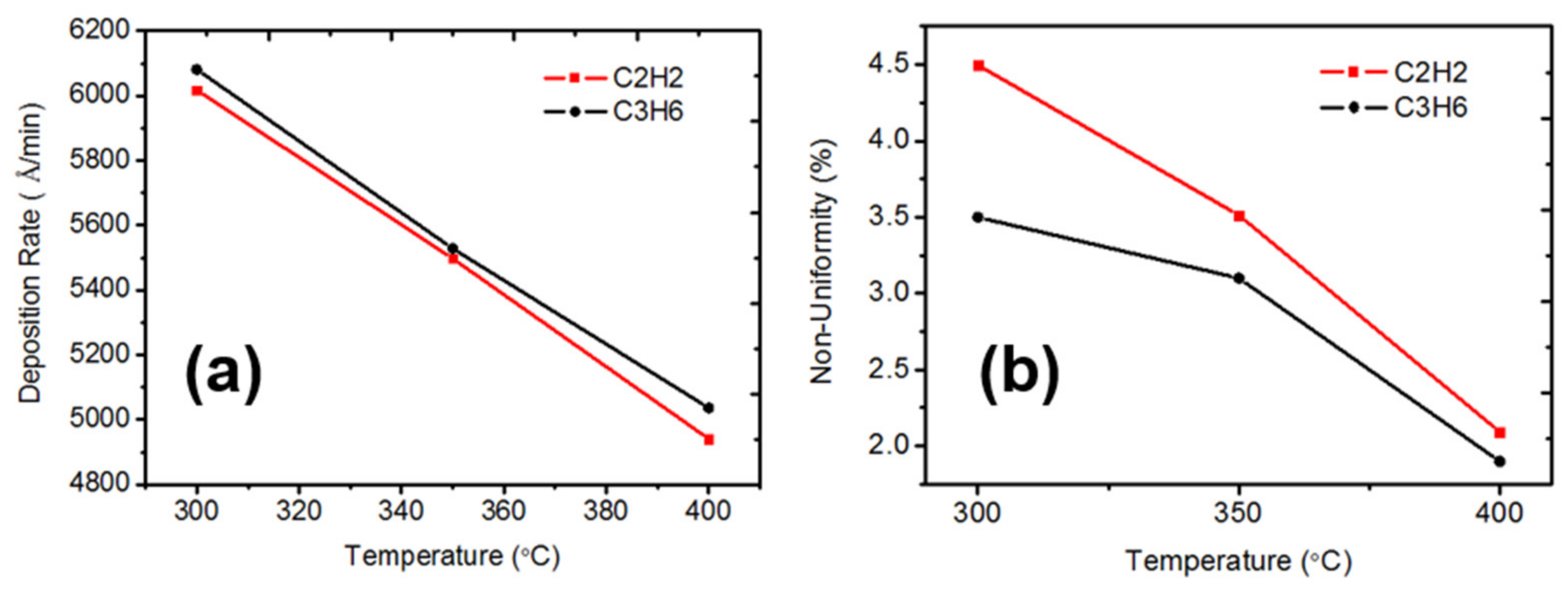

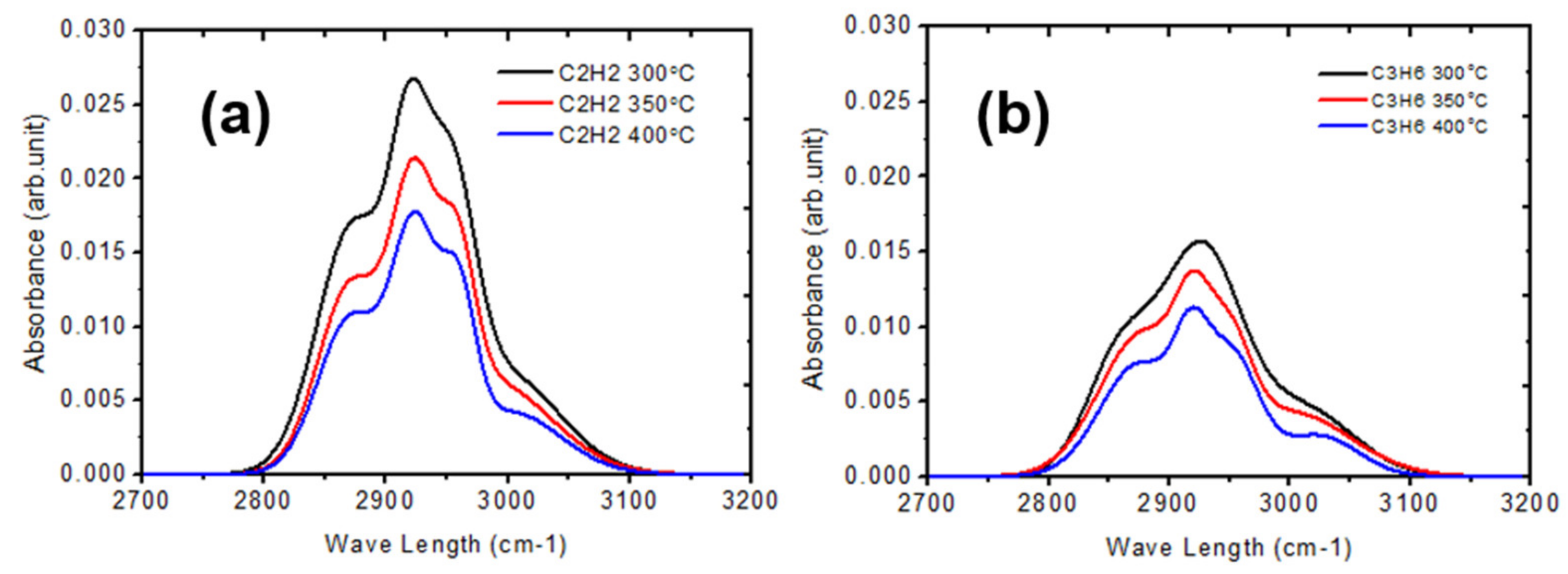
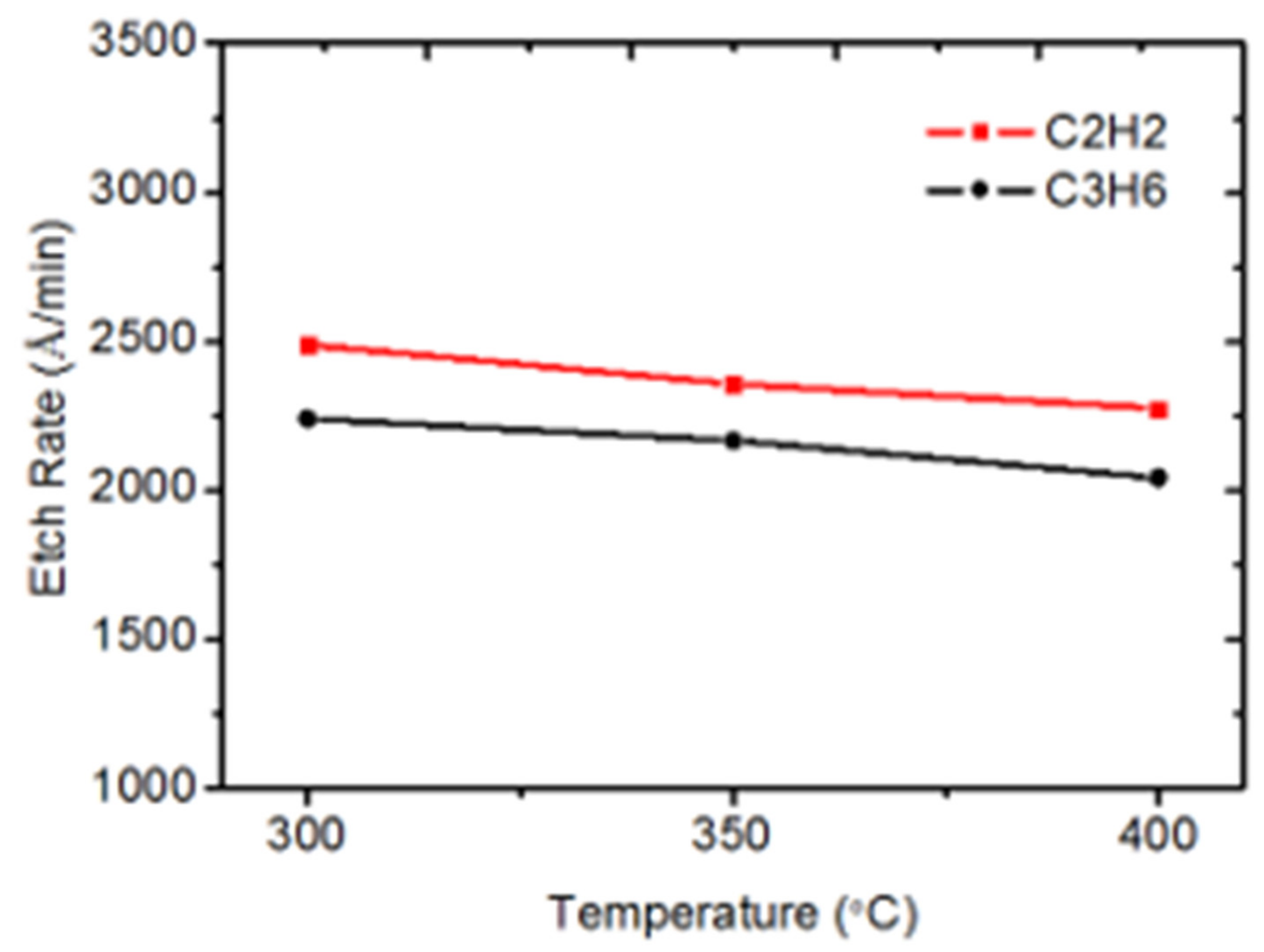
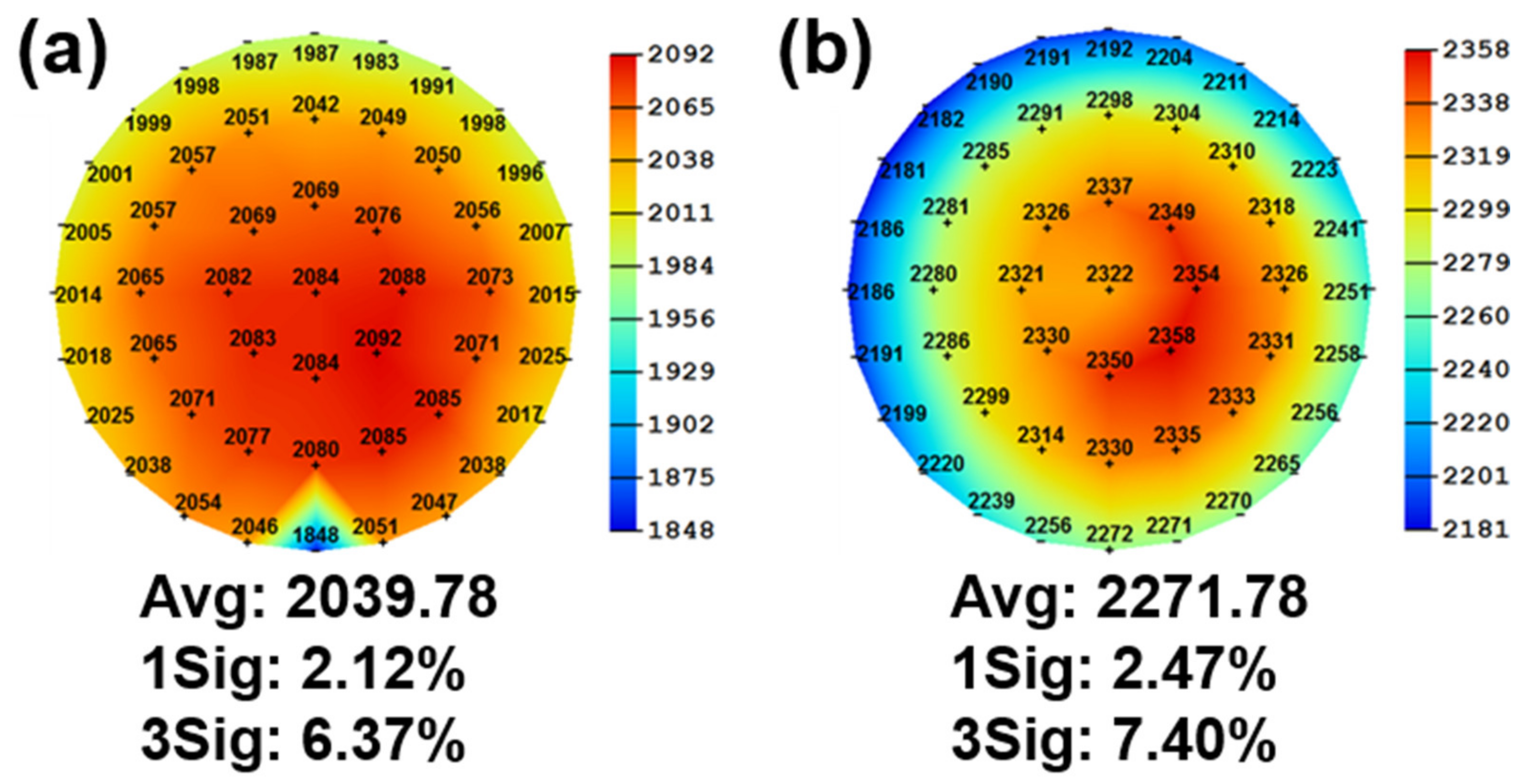
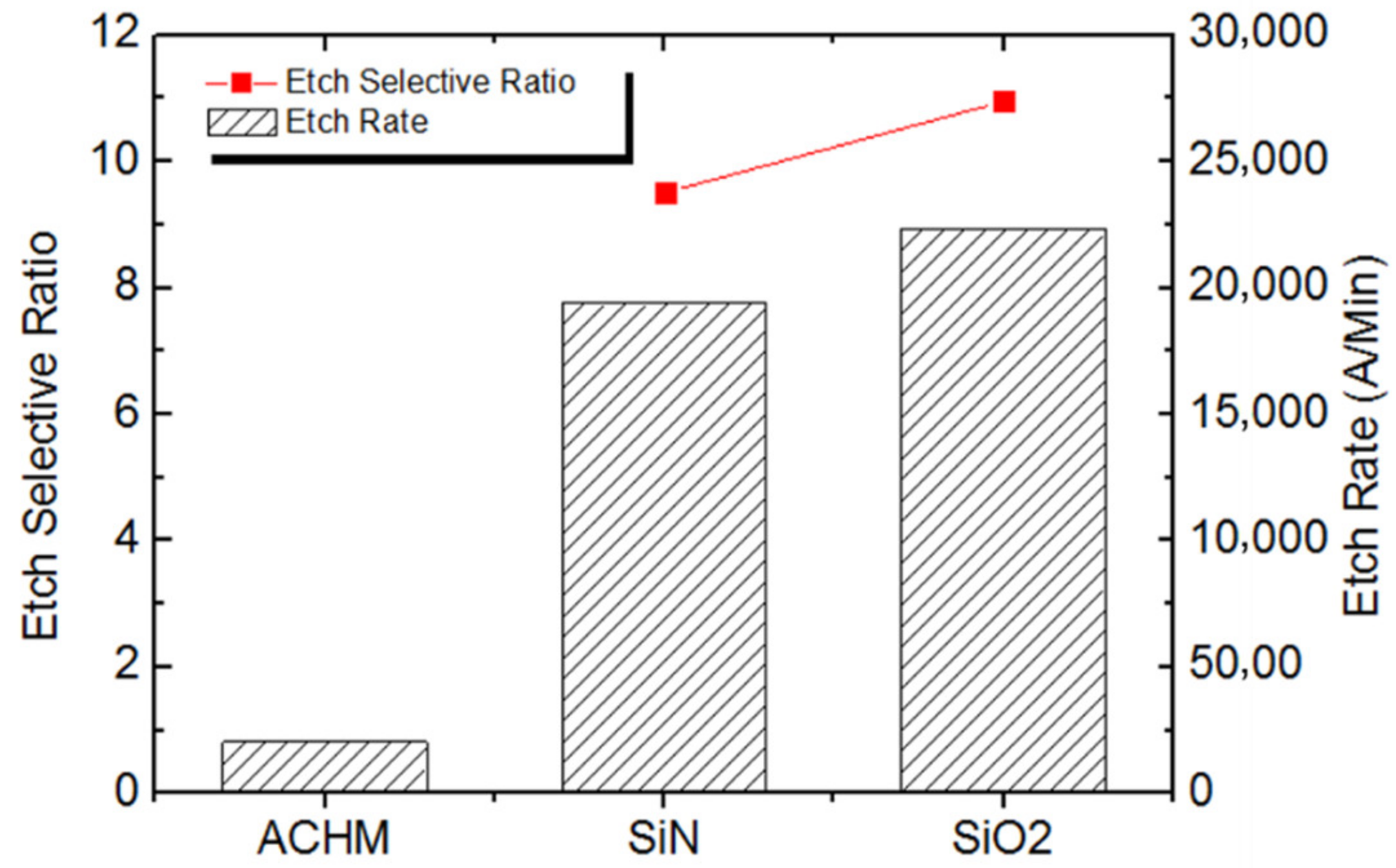
Publisher’s Note: MDPI stays neutral with regard to jurisdictional claims in published maps and institutional affiliations. |
© 2021 by the authors. Licensee MDPI, Basel, Switzerland. This article is an open access article distributed under the terms and conditions of the Creative Commons Attribution (CC BY) license (https://creativecommons.org/licenses/by/4.0/).
Share and Cite
Jiang, Z.; Zhu, H.; Sun, Q. Process Optimization of Amorphous Carbon Hard Mask in Advanced 3D-NAND Flash Memory Applications. Electronics 2021, 10, 1374. https://doi.org/10.3390/electronics10121374
Jiang Z, Zhu H, Sun Q. Process Optimization of Amorphous Carbon Hard Mask in Advanced 3D-NAND Flash Memory Applications. Electronics. 2021; 10(12):1374. https://doi.org/10.3390/electronics10121374
Chicago/Turabian StyleJiang, Zheng, Hao Zhu, and Qingqing Sun. 2021. "Process Optimization of Amorphous Carbon Hard Mask in Advanced 3D-NAND Flash Memory Applications" Electronics 10, no. 12: 1374. https://doi.org/10.3390/electronics10121374
APA StyleJiang, Z., Zhu, H., & Sun, Q. (2021). Process Optimization of Amorphous Carbon Hard Mask in Advanced 3D-NAND Flash Memory Applications. Electronics, 10(12), 1374. https://doi.org/10.3390/electronics10121374




